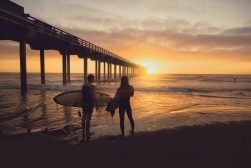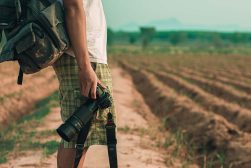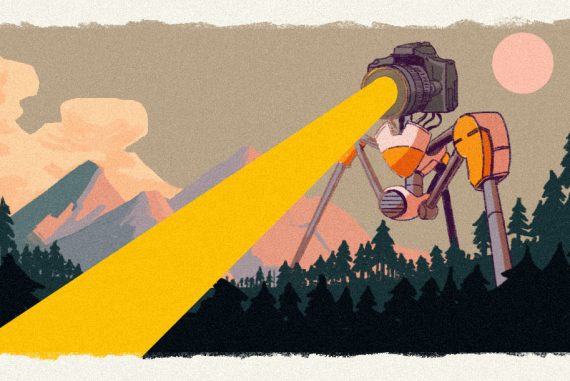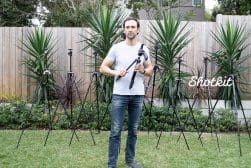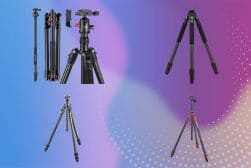
Guide to Desert Photography
How do you photograph a desert? Learn what camera gear, the clothing, safety precautions, camera settings & more - everything to know about desert photography.
Learn | Photography Guides | By Ana Mireles
The desert is one of the favourite environments of landscape photographers, but how do you photograph a desert?
If you’re looking to venture into the exciting field of desert photography, you’ll need to prepare yourself and your gear so that you come back safely and with a collection of stunning images.
In this article, you’ll find some guidelines on what to wear, what to pack, which gear you’ll need, and more.
You’ll also find some photo ideas to make the most out of your trip, a few desert photography quotes and a handful of example images of the desert landscape to get you inspired.
7 Desert Photography Tips for Amazing Images
1. Bring the right gear (and something to protect it)
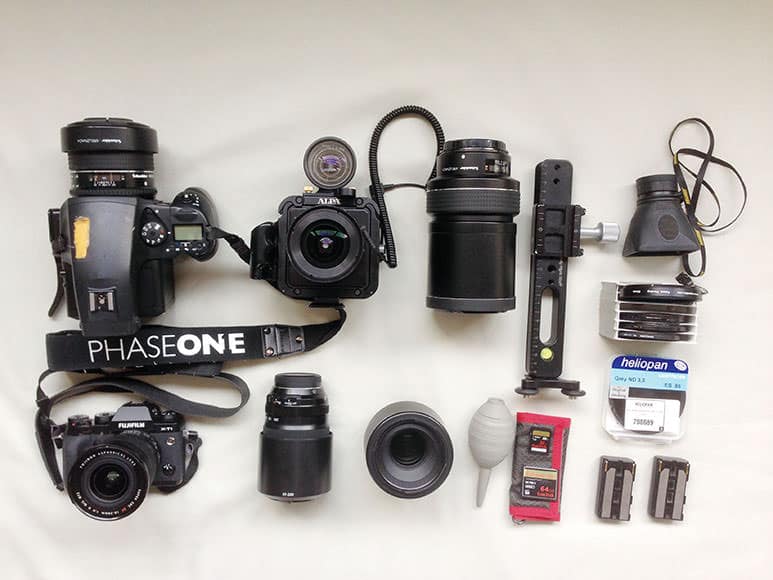
Camera gear of landscape photography master Peter Eastway.
The desert is usually not a close or easy thing to visit. So, once you’re there, you’ll want to make the most out of your photoshoot.
You should bring the most suitable equipment to do this – and you need to make sure you’re protecting it properly.
- Camera
Any DSLR or mirrorless camera is good for shooting desert landscape photography. However, a full-frame camera allows you to have more detail if you plan to have your images printed on a large scale or featured in a magazine or book.
If you have a second camera, it’s always a good idea to bring it with you – it can be for backup or to have a second perspective, focal length, etc.
- Lenses
The best focal length for desert photography depends on the type of images you want to capture.
A wide-angle lens allows you to capture sweeping landscapes or interesting details close to you. On the other hand, a telephoto lens allows you to photograph details that are far away – which is great for capturing out-of-reach areas.
Remember that changing the lens while you’re out in the desert exposes the sensor to sand, which can cause severe damage to your camera.
That said, there are some alternatives that allow you to still have a variety of focal lengths available.
For example, if you have two cameras and you can bring each one with a different focal length – then, you’re good to go.
Or, if you can change lenses in a closed environment – like if you’re camping and can go into the tent, or you have your car close by – then you shouldn’t have any problems.
Finally, you can use a zoom lens instead of prime lenses to avoid having to change them out in the field. However, this is a bit risky as the sand can get in the case when you zoom in and out.
There’s a lot of debate on whether or not a UV filter is as useful for digital cameras as it was for film cameras.
Wherever you stand on this issue, in the case of desert photography it’s still recommended to use one because it can protect the front of the lens from getting scratched with the sand.
As far as technical needs, it’s a good idea to bring a polarizing filter for strong light reflections, a neutral density filter if you want to do some long exposure shots during the day, and a graduated neutral density filter for highly contrasted scenes.
- Tripod
A steady tripod is key to getting sharp images if you’re using slow shutter speeds. This is often the case if you’re photographing during the first and last hours of the day – which is always advisable for landscape photography, and of course, for night photography.
However, even if you plan to photograph in broad daylight, strong winds can cause camera shake – so it’s always best to use a tripod.
Pro tip: Adding some tripod ‘shoes’ to your arsenal will certainly come in handy to avoid the tripod sinking in the sand. Most of the best DSLR tripods feature replaceable feet.
How Much Do You REALLY Know About Photography?! 🤔
Test your photography knowledge with this quick quiz!
See how much you really know about photography...

- Remote trigger
Whenever there’s a risk of camera shake, it’s always better to use a remote trigger. This way, you eliminate the risk of moving the camera while you press the shutter.
- Spare batteries and memory cards
The same advice applies here as for the lenses – it’s never a good idea to change your battery or memory cards out in the desert. So, it’s best to have a full battery and an empty memory card inside the camera(s) before you leave for the trip.
Even though changing batteries and cards is inadvisable during desert photography, it’s still good to be prepared with spares in case of any malfunction.
If this happens and you need to change anything, make sure you do it as fast as possible and cover the equipment from the wind to diminish the risk of getting sand inside the camera.
- Cleaning kit
If you’re shooting a desert landscape during a windy day or adverse weather conditions, trying to clean your gear on the spot will be a lost battle.
However, on an average day in the desert, you’ll have to deal with dust and sand, which you can deal with using compressed air, for example.
It’s also a good idea to clean everything before you put it back in the bag. Here’s how to clean your lens.
- Weather sealed camera bag
I know weather sealed camera bags are more expensive than regular bags, but fixing or replacing a piece of equipment will cost you a lot more. Sand can be your camera’s worst enemy – so you better keep it as protected as possible.
You also have to consider extreme temperatures, rain, etc. That’s why investing in a good camera bag can be one of the wisest decisions you make for a photographic trip to the desert.
Also, consider the comfort factor because you might have to do some trekking to reach the best desert photography locations.
2. What else to pack for desert photography?

Credit: Abby Kihano
In desert photography, you need to pack more than your photographic gear – especially if you’re going to a location that’s far from service stations.
- Water bottles
Yes, bottles in plural – water is more important than food. You can use a hydration calculator to get an estimate of how much water you’re going to need.
You should also consider using a Camelbak or similar water bladder which can be carried in your camera backpack to ensure you stay hydrated.
- Flashlight
If you arrive before sunrise or stay after sunset, a flashlight or a headlight will come in handy to set up or pack, adjust the tripod and gear, and even walk around safely.
This is especially true if there isn’t a full moon. You can also use this for some light painting experiments.
Look for a headlight with a red light setting, which can be especially handy when you don’t want to ruin your night vision when photographing at night.
- Sunglasses
This is obviously to protect your eyes from bright sunlight – however, it’s also useful to shield your eyes from the sand. If you know you’ll be facing desert storms, make sure you bring goggles.
- GPS
Don’t rely on your phone for directions – many times, you’ll find yourself without a signal when you go into the desert.
- Sunblock
If you plan to photograph during the daytime, then you’d better bring some sunscreen with you. Remember to reapply if you’re staying long.
3. Understand the camera settings for the best results
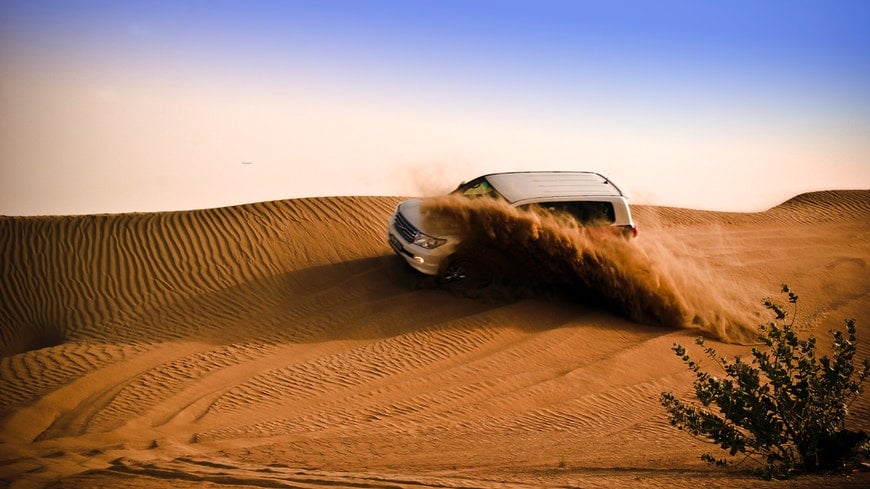
Credit: Carlos Herrero
Determining the best camera settings for desert photography is a tricky thing – it depends on the type of desert photos you want to take and the conditions you’re facing.
It’s not the same if you want to photograph the moon over a desert landscape as it is to capture sand dunes with strong shadows in the middle of the day.
There are a few things that you can consider when choosing your settings. As you probably know, exposure is determined by three factors: aperture, shutter speed and ISO. The important thing is that you learn which one to prioritize.
If there’s a moving subject or you want to capture motion, you need to choose the shutter speed first – then adjust the other two for correct exposure.
On the other hand, if you have a static scene and are using a tripod, you don’t have to worry about the shutter speed.
Consider the aperture to control the depth of field and use the lowest ISO possible to preserve the image quality and avoid noise in your images.
To have a better light reading, don’t forget to choose the best metering mode for the situation. For example, if you want to photograph a silhouette or there is backlighting, it’s best to use spot metering mode.
Once you take the photo, don’t forget to check the histogram to make sure everything is properly exposed. Some bracketing shots are always a good idea – especially if your desert landscape scene is very contrasted.
4. Invest in proper clothing

Desert Floor | Credit: Walid Ahmad
What do you wear to a desert photo shoot? That’s an important question because deserts have very extreme temperatures, and you’re going to be out there for long periods of time.
Layering is a big part of dressing for the desert. You can go from extreme heat (an average of 38° C/100° F) during the day to a -4° C (25° F) at night. Of course, this varies according to the time of the year and which part of the world you’re in.
For the heat, wear natural fibers such as cotton that don’t adhere to the body – this way, the air can circulate.
Use long sleeves and pants to avoid sunburn and getting hurt with branches or thorns. Sunglasses are very important to protect your eyes as the sand can be very reflective.
For the cold, you should wear clothing that keeps you warm for as long as possible.
In both situations, it’s important to wear a good pair of trekking or hiking shoes. This will protect you from hurting your feet and your spine since desert photography often involves walking long distances with a heavy camera bag on your back.
5. Make sure you do some weather planning
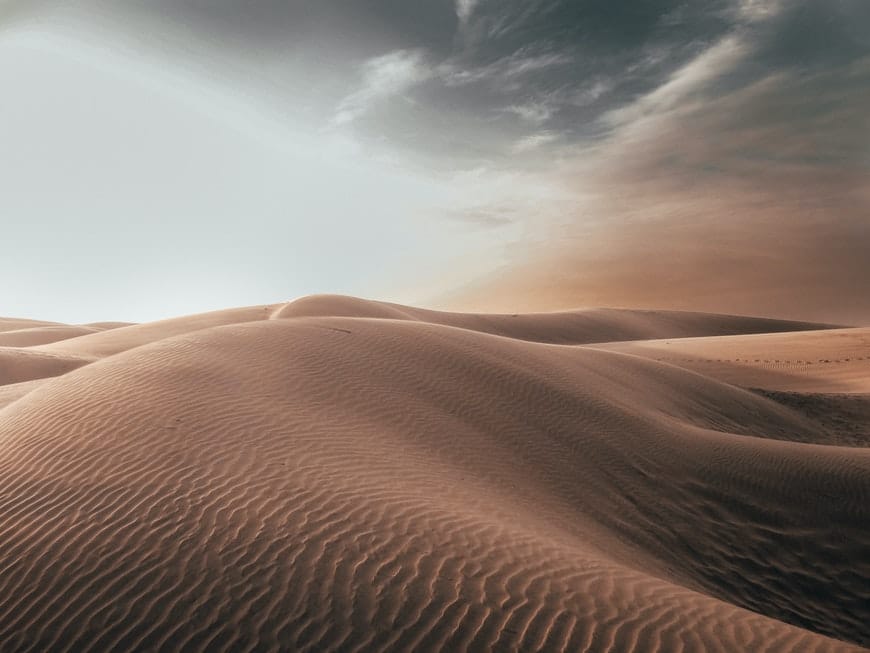
Desert dunes | Credit: Sharad Bhat
When it comes to desert photography, each time of the year presents different challenges and opportunities.
Spring is one of the most forgiving seasons because the temperatures are less extreme. Also, if you want to photograph some desert wildflowers, this is the best time to do it.
If you’re a storm hunter, then you’ll probably want to plan a desert shoot during the summer. It can be quite difficult to deal with the heat – however, it’s monsoon season, so you’re likely to get some breathtaking landscapes.
Autumn is great to photograph the night sky because the temperature at night starts to drop, but it’s still not too cold.
Winter is probably the last period of the year you would think of going out to photograph the desert. In fact, it can be a harsh environment – but it offers the possibility to do some stunning images with the ice or snow, the rainfalls, etc.
Obviously, the weather conditions aren’t the same throughout the entire season. Once you’ve picked a time of the year, you should monitor the weather for the exact dates of your trip.
Landscape photographers very much appreciate Accuweather because it tells you when it’s going to rain, what the cloud coverage will be, and lots of other helpful details (all with a good accuracy rate).
PhotoPills is another useful app to plan your trip with some forecast information.
You should also check for the sunrise and sunset times if you want to photograph during the blue hour and golden hour. That way, you can plan the best time to arrive and set up before those precious moments start.
The Photographer Ephemeris is another useful tool for this. Unfortunately, it’s not available for Android – but you can use the browser version.
6. Scout your location before the trip
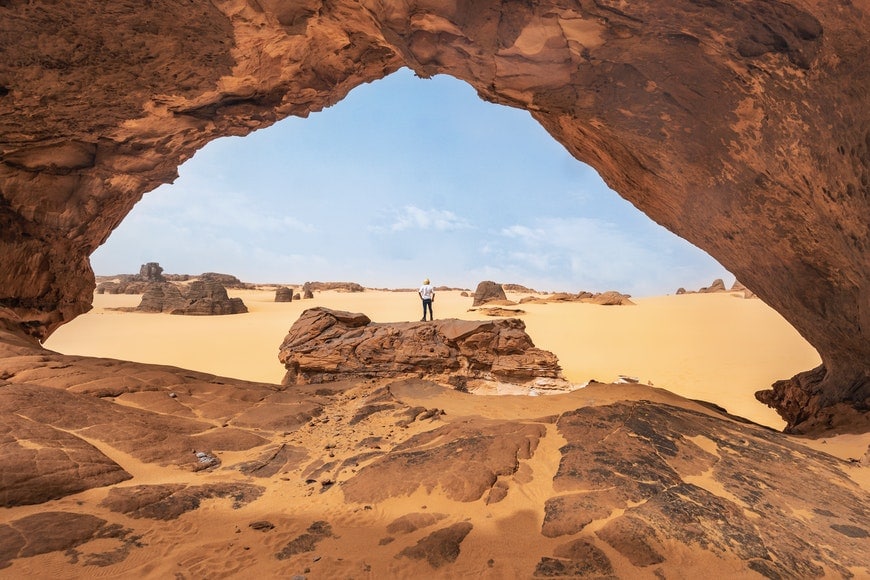
Credit: Noureddine Belfethi
If you’re interested in photographing the desert, you already know that it isn’t just a big sandbox. There are sand dunes, slot canyons, etc.
To find the best spot with interesting elements, you should scout your desert photography location in advance. It’s not always possible to do this physically; fortunately, there are ways to do it virtually.
Google Maps is the first tool that comes to mind when we’re trying to find a location in everyday life. It’s also a great way to start as a landscape photographer.
First, you can see how to get to your desired location and how far can you get by car.
Then, you can move on to street-view so that you can see what the place looks like – if it’s open desert, if there are plants, etc.
This step is easier if you’re scouting popular locations such as the Death Valley National Park, the Bryce Canyon National Park or any place where other photographers have already shared their images to complement Google’s information.
There’s also Google Earth which allows you to see locations at ground level or from a higher angle of view.
With Google Earth, you can measure distances – which will help you decide if you’ll need a wide-angle lens, a telephoto lens, or both.
Once you’ve decided where you’re going and how to get there, you need to research some other important information.
Do you need a permit to visit and/or photograph this location? This may change depending on where you live.
For example, about a fourth of all the national parks require an entry fee in the US. Even when the entrance to the park is free, sometimes you need to apply and pay for a permit if you intend to photograph or film (though usually, this applies only if you need to bring models, props, flashes, etc).
Can you camp at the same location? If you intend to shoot the night sky, you’ll need to spend the night, so you have to make sure this is possible.
Otherwise, research the opening times. Remember that soft light happens early in the morning and late in the evening.
If you’re going for highly contrasted scenes, you need hard light – but it’s better when it’s coming from an angle, so it’s still a good idea to avoid the middle part of the day.
Is there wildlife? Animals are part of the natural environment. Whether you want to incorporate animals into your desert landscapes or avoid dangerous wildlife, it’s a good idea to be informed before your trip.
Are there any other customs or regulations that you need to be aware of? From restricted areas to preserving the environment, a photoshoot in the desert requires knowledge beyond photographic skills. Make sure you go as prepared as possible.
7. Don’t forget about post-processing
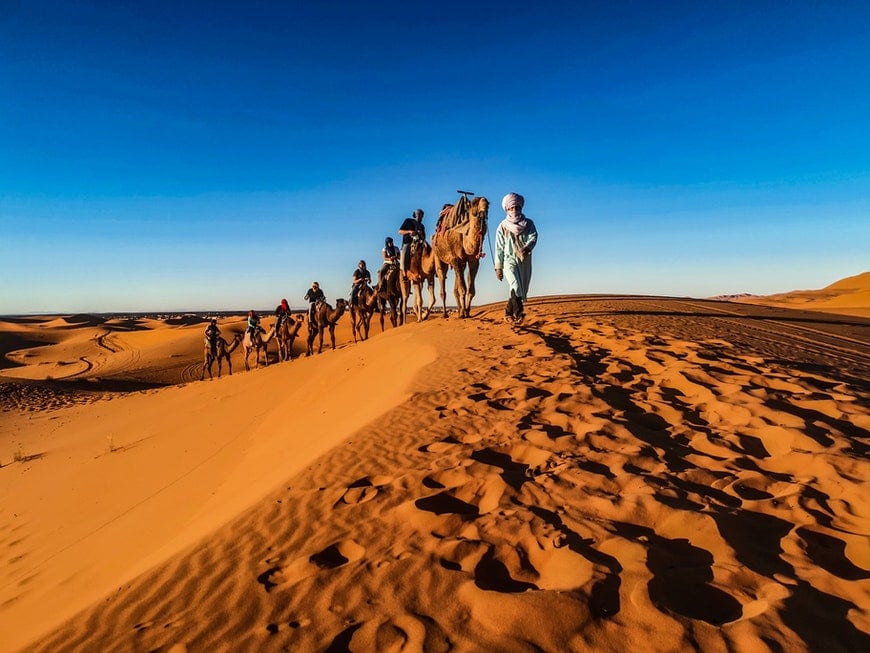
Credit: Henrik Lebotos
Post-processing can certainly take your desert photography efforts to the next level.
If you were out shooting in high winds blowing sand, you could end up with some flat images. Use Dehaze in Lightroom to add some contrast and saturation.
Also, to increase the contrast (whether you were in a sand storm or not), you can adjust the highlights and shadows. This will create depth in the image and will help you to emphasise natural patterns such as cracked mud.
If you didn’t have a graduated neutral density filter with you and there was too much difference in the exposure of the sky against the foreground, you can make some selective adjustments.
You can use the Graduated Adjustment filter in Lightroom or an Adjustment layer with a gradient applied as a layer mask in Photoshop.
The Clarity and Texture sliders help you bring out the details without oversaturating them, so these can be helpful when you have intricate patterns in the image.
If you’ve only got limited time to shoot and there’s no texture or interest in the sky, remember that you can always use software such as Luminar Neo (reviewed here) to add a realistic sky in post-production too.
10 Desert Photography Ideas
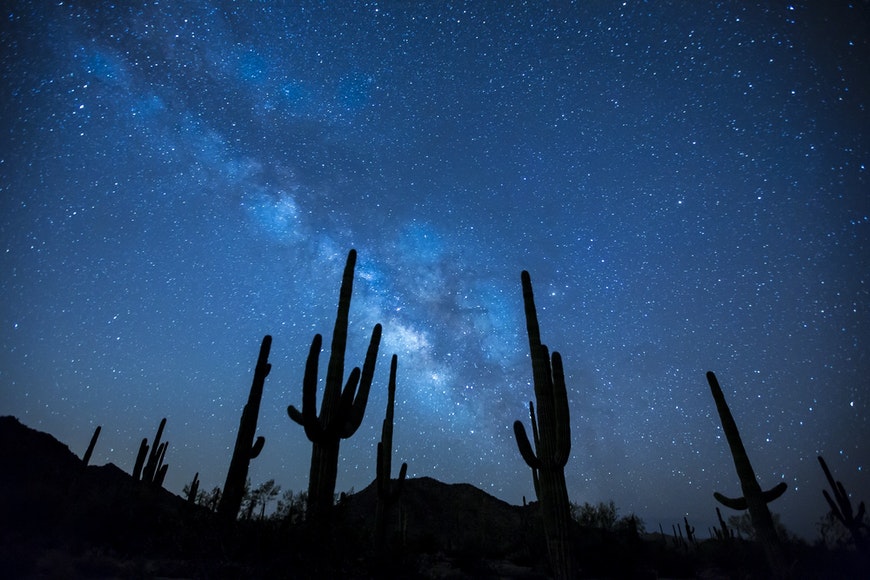
Credit: Pixabay
Ever wondered what to photograph when in the desert? Having a model would be great, but that’s not always possible, so here are 10 ideas:
- Mirages – A mirage is an optical illusion often found in desert landscapes caused by light diffraction. If you can see it, so can your camera.
- Patterns – Desert photography often involves patterns because they can be in the sand, the rocks, the plants, etc. You’ll have plenty of texture to find interesting patterns. You can also create your own patterns by drawing in the sand, for example.
- Wildlife – Aside from the popular camels in the Sahara, many animals live in the desert. Depending on the area, you might find some really astonishing models for your desert photography. For example, goats in Australia’s Simpson Desert, gray foxes in the Atacama Desert in Chile, meerkats in the South African Kalahari or a gemsbok in Namibia’s Namib Desert.
- Black and white landscapes – Desert landscapes are subjects that render really well in greyscale. You can take the photographs in color and change them to black and white in post-processing. This way, you’ll have both choices to choose from. Any photo editing program allows you to do this.
- The Milky Way – The desert is a great place to photograph the milky way – or shoot astrophotography in general because there’s less light pollution than you normally find in the city. Use a wide-angle lens to capture a big piece of the sky and incorporate part of the landscape to make a more interesting composition. Start with a 30-second exposure and make adjustments from there. Keep in mind that you can shoot multiple images and blend them together in Photoshop later for striking results.
- Leading lines – Composition rules are as important in desert photography as they are in any other photographic genre. Leading lines are particularly useful because they can help you to ‘pull in’ the viewer and add depth to the image in such a vast space.
- Silhouettes – For a fun and creative photo, you can incorporate silhouettes into your desert photography. This can be of a model, a cactus, or any other object you can think of. The trick is to shoot against the sun, then determine the correct exposure for the background – this will underexpose the subject leaving only the black shape.
- The moon – To photograph the moon, you’ll need a telephoto lens – unless you want to include the landscape in the foreground, then you’ll need a shorter focal length. Use the spot metering mode of your camera to determine the right exposure. Try to keep a low ISO and a small aperture for sharper images. This will result in longer shutter speeds, but you shouldn’t have any problems using a tripod and a trigger.
- Footprints – You can use your own footprints or look for interesting images with the ones left by other people. Using footprints, you can photograph patterns, leading lines, etc.
- Plants and flowers – Flower photography is not the first thing that comes to mind when you’re doing a desert photoshoot, but the desert is an ecosystem that hosts a wide variety of plants and flowers. Depending on the time of year, you’ll have different photo opportunities. In spring, you can find a colorful landscape with flowers in bloom. You can find blooming flowers like the coral and red penstemon in the Arizona desert even in winter.
12 Desert Photography Quotes
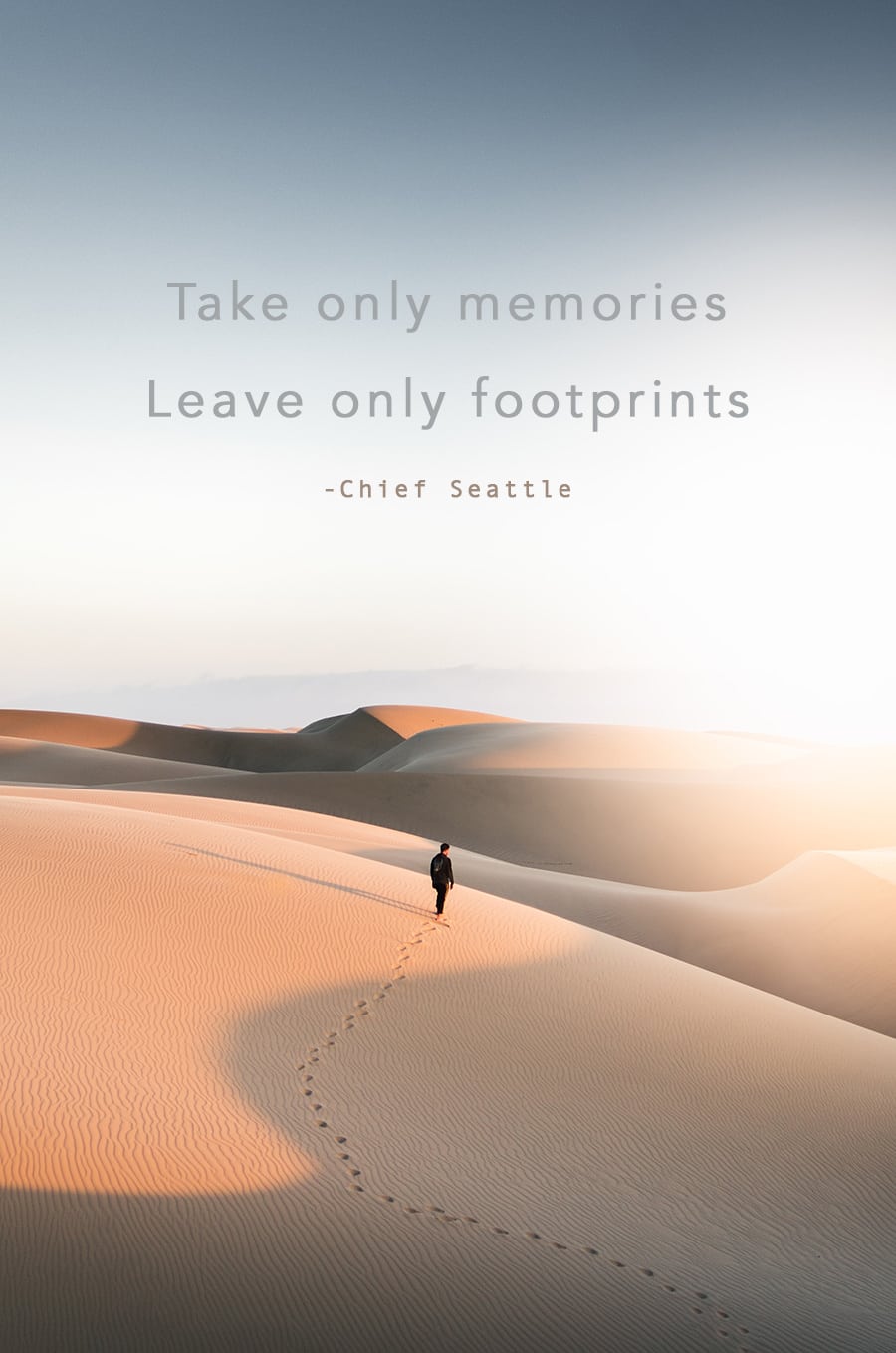
Credit: Kyle Cottrell
Looking for something to caption your latest desert photography image for Instagram? Here are some popular quotes you could use:
- “What makes the desert beautiful is that it hides, somewhere, a well.” – Antoine de Saint Exupéry in The Little Prince.
- “It’s a little lonely in the desert… It is lonely when you’re among people, too,” – Antoine de Saint Exupéry in The Little Prince.
- “You can’t fight the desert. You have to ride with it.” – Louise L’Amour.
- “I love the desert and its incomparable sense of space.” – Robyn Davidson.
- “The desert tells a different story every time one ventures on it.” – Robert Edison Fulton Jr.
- “On your journey to your dream, be ready to face oasis and deserts. In both cases, don’t stop.” – Paulo Coehlo.
- “The desert is a natural extension of the inner silence of the body.” – Jean Baudrillard.
- “Magic of the shadows can best be seen in deserts.” – Mehmet Murat Ildan.
- “A forest is mystery but the desert is truth.” – Keith Miller.
- “Take only memories. Leave only footprints.” – Chief Seattle
- “The desert is an ideal illusion of a blank slate – so much mystery in endless layers is hidden underneath its bright, pseudo-sterile surface.” – Vera Nazarian.
- “If you sing of beauty though alone in the heart of the desert you will have an audience.” – Khalil Gibran.
Final Words
Photographing the desert is not the easiest thing to do – but you’ll quickly find that it’s totally worth it.
I hope this article cleared up your doubts on how to go about it and gave you some creative ideas for your upcoming desert photography trip.
If you have any other questions or you want to share your own experiences, please do so in the comments section. We’re always happy to hear from you!

Check out these 8 essential tools to help you succeed as a professional photographer.
Includes limited-time discounts.






